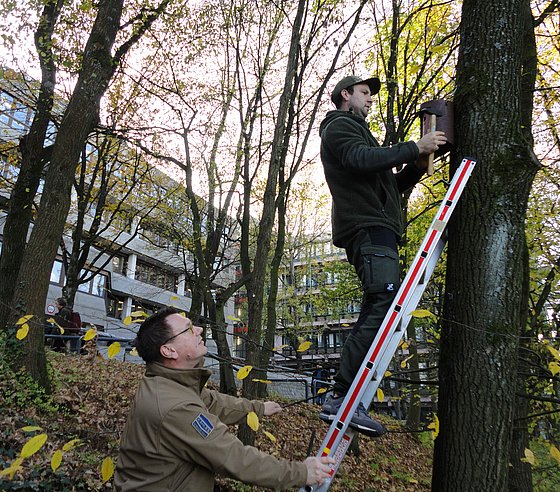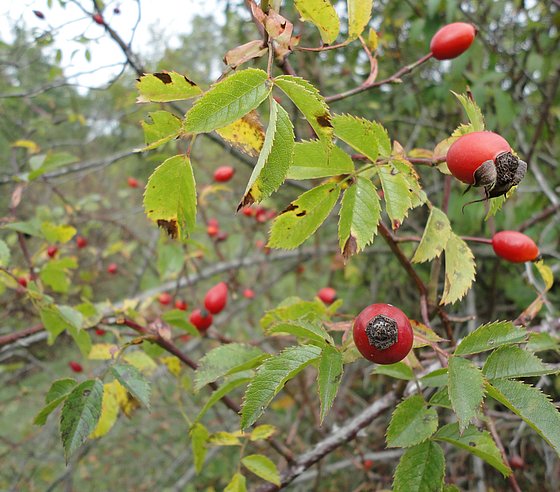
Installation of tit boxes, Mr Schürhoff and Mr Sondermann (both Department 5)

Rosehips (fruits of wild roses)

Fruits of the coneflower
Birds - nesting aids & bird feeders
Who hasn't seen this scene before: rubbish bins surrounded by scattered packaging and food scraps? Not all of the birds in gardens, parks or on the university campus are so conspicuous, but you can still see blackbirds, chaffinches, blue tits, great tits, robins, house sparrows and wrens, and sometimes even a nuthatch or a green woodpecker.
Over 300 species of bird breed in Germany. They differ, for example, in their choice of nesting sites. Cavity-nesting birds either nest in holes in old trees, like blue tits, or in crevices, burrows, or holes in walls, like swifts. The nests of open or semi-cavity breeders are more exposed and must be protected from predators such as domestic cats. Such nests can be found in hedges, treetops or on the ground. Birds use various materials to build their nests, such as brushwood or moss, which they intricately weave together.
If there are not enough natural nesting sites available, various boxes or aids can encourage birds to settle. However, birds will only nest where they can find sufficient food and water, as well as suitable nesting sites. Food sources can include a wide variety of insects and their larvae, such as butterfly caterpillars, spiders and worms, as well as seeds and fruits from plants.
Therefore, a bird-friendly site should have a variety of structures to satisfy the different feeding and nesting preferences of various bird species. Useful elements include old or hollow trees, shrubs, and perennials that harbour insects and provide them with food. These insects then serve as a food source for birds. Hedges of native shrub species that provide both protection for birds and food in the form of fruit and seeds, as well as thorns and spines to protect nests from predators, are particularly valuable. Examples include hawthorn, on which more than 160 insect species have been recorded, and various wild roses with their rose hips.
Nesting boxes on the university campus: with blue tits against the oak processionary moth
Numerous blue tit nesting boxes have been installed on the Grifflenberg campus. This project was led by Mr Schürhoff (Department 5) and supported by Mr Sondermann (Department 5) and Mr Greiling (ZIM). The boxes were placed in the oak trees in particular, and not entirely 'altruistically'. Oak trees can become infested with the caterpillars of the oak processionary moth (Thaumetopoea processionea), which is a type of moth. These caterpillars feed on oak leaves and the hairs of older caterpillars contain a poison similar to that found in nettles, which can cause skin inflammation (caterpillar dermatitis) or respiratory problems in humans. Due to mass reproduction, the oak processionary moth is now widespread throughout Germany and also in North Rhine-Westphalia (NRW). However, blue tits are the natural predators of the caterpillars. The nesting boxes have therefore been installed on the university campus to encourage blue tit populations and keep the oak trees free from oak processionary moths.
Hedges with bird food and bird protection shrubs
To increase the supply of seeds and fruit for birds, the botany working group has planted several groups of shrubs and hedges. As insects form part of a bird's diet, we have also planted shrubs that provide a habitat and food for insects (e.g. buckthorn, wild roses and hawthorn). Some of these shrubs have thorns and spines, providing sheltered nesting sites.
